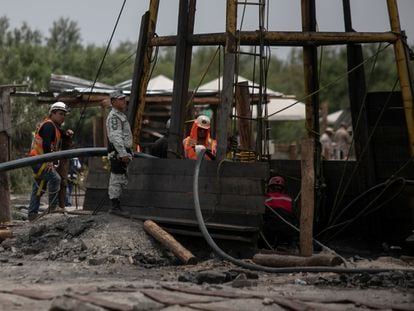A terrible reminder impregnates the passing of the hours in Coahuila: the nights pass, the dawns, the day and 10 miners remain buried in the bowels of the Las Conchas mine, in the town of Sabinas.
The three wells, on which iron castles are erected, concentrate the rage and misery of a region condemned to seek its future underground.
The atmosphere seems calm, although everyone knows that a battle against time and statistics is being waged inside to save the workers alive.
The main enemy is the underground water that the men found when they were digging for coal and caused the collapse.
Before rescue teams can venture into the tunnels, the liquid has to come out.
The hours go by and the sun, which seemed to have given the rescuers a truce early in the morning, begins to punish.
The tension shoots up at the same time as the temperature: the relatives of the miners stir restlessly, they protest, they no longer trust what the authorities tell them.
In addition, the Army has expanded the security perimeter—in some places it has even put up barbed-wire fences—and no one can get closer than 30 meters.
The feeling that is breathed is that something decisive is about to happen, although nothing has happened and the situation is almost identical to a few hours ago.
The only exception is that during the night one more pump has been placed—18 have been brought in—to extract the water, which pours out through a channel cut in the ground and runs down the valley.
The relatives, who can do nothing but think and wait, fix their eyes on that coal-stained river from time to time.
Their hopes of seeing them alive again depend on the speed and size of the channel.
Aerial view of the rescue teams and the three wells at the Las Conchas mine, in Coahuila.
LUIS CORTES (REUTERS)
The Mexican president, Andrés Manuel López Obrador, has maintained that this Saturday would be a key day in the search: “According to the technicians, it will be known if there is a possibility that the divers will enter without risk.”
However, in the mine nobody thinks that the divers are going to enter: it is not well known what conditions the bottom of the shaft is in and it could be dangerous.
One of those in charge of the drainage pumps, on condition of anonymity, explained to EL PAÍS that it is more likely that the water will be emptied first and then the rescuers will enter, although according to his calculations, that would not happen until Sunday. .
David Huerta, a veteran miner, believes that with the increase in water that is being extracted, there is a possibility that the rescue teams could enter between tonight and tomorrow morning.
“Time is eating us up”, stated the Governor of the State, Miguel Riquelme, who added that more equipment is going to be bought.
—We are waiting night and day for an answer: if they are advancing, if they are alive, but right now it is already too late.
It's been many days, we're already waiting for them to just take out the body and give it to us.
Hugo and Raimundo Tijerina's aunt, who prefers not to give her name, thinks differently from the president.
Like so many other relatives, she has been sheltering in the sun in a bush since the day of the collapse, sleeping on the ground.
Her nephew Raimundo de ella was saved from the collapse because he went out to get his lunch.
But his brother, Hugo, is still inside the well, so he has been participating in the rescue efforts all this time.
"I have hope that it will turn out well because he is married and his children are suffering, but it is too late," the woman resigns.
Rescuers work around one of the wells to save the 10 workers trapped under the mine, this Saturday in Coahuila.
EMILIO MIRROR
“There have been many accidents here, but a few weeks go by and they continue working again.
The children need money and they get involved again.
They have to work wherever because they have a family to support,” she adds.
She points out that they do not know anything about the boss, that he has not come forward or shown his face, and that a mine manager is giving the relatives papers to sign, according to her, to get rid of responsibility.
“They did not have insurance, security measures, or records of who entered or left the mine.
At the expense of the fucked up they feed themselves”.
Most of the relatives have spent the night hanging around the Army's security perimeter, sleeping in the dust with only a blanket or on plastic chairs.
Some of the volunteers, those who had been collaborating from the beginning, were sent home around two in the morning to rest, but they all return to continue the search.
Elba Hernández has spent four days in front of the main entrance of the mine, since the day of the collapse that imprisoned her son-in-law, Margarito Rodríguez (54 years old), a miner "since he was old enough to work."
At 71, the woman's feet have swollen from spending three nights outdoors and four days in the desert sun.
“We are bad, no more than we act strong to give strength to my daughter, that she is with her closest relatives [inside the mine only one relative is allowed].
We are not going to leave until they come out ”, she sentences.
The operators drill into the ground to see if it is possible to introduce another drainage pump for the water that floods the mine.
EMILIO MIRROR
Above the conversations, the roars of machines drilling into the ground can be heard.
Also the song of the cicadas that certify that the heat is increasing.
On the faces the sweat mixes with the dust.
Elidio Castillo, an engineer at Minera del Norte, explains that a geophysical survey is being carried out in the fields surrounding the mine to see if they can introduce more pumps and speed up drainage, although the process is long: three hours of drilling just to test the ground, followed by about 40 hours until the liquid begins to come out: "We are contributing our grain of sand, but it is complicated, the volume is very large."
There are plenty of hands that want to dig the earth to get men out alive.
On the other side of the camp, Isidro Cosme (45 years old) stares at the towers.
A lifelong miner and son of a miner, he knows all the buried workers.
“I come in case there is a way to go down for my companions.
We have always worked together, but they are here right now and I am on the other side of the river, in a hole just like this one”.
Cosme gives a masterful lesson on why thousands of men in Coahuila continue to risk their lives in the tunnels: “I take risks for my family, I'm not going to be filthy kidnapping people and stealing;
the maquiladoras don't even pay you for the roll you spend in the bathroom, you don't live with that money, it's not enough”.
As he speaks he pulls his shirt over his face, bites it, looks down at the ground, and finally retreats behind some trees with glassy eyes.
When he thinks that nobody sees him, he slips under the security perimeter and disappears among the volunteers: behind his companions.
subscribe here
to the
newsletter
of EL PAÍS México and receive all the informative keys of the current affairs of this country


/cloudfront-eu-central-1.images.arcpublishing.com/prisa/NHAGPMQH45FWPHD273W2SBSACU.jpg)



/cloudfront-eu-central-1.images.arcpublishing.com/prisa/WC4GA6WVUFH2FKPJBPH6464HLM.JPG)

/cloudfront-eu-central-1.images.arcpublishing.com/prisa/V3OC5EYQQZGJZP7PIPZWHG3WDM.jpg)

/cloudfront-eu-central-1.images.arcpublishing.com/prisa/2C5HI6YHNFHDLJSBNWHOIAS2AE.jpeg)




